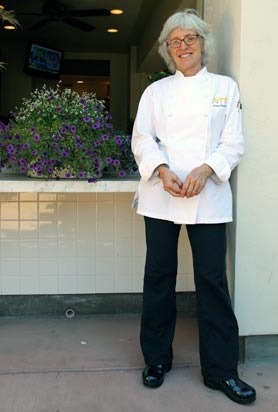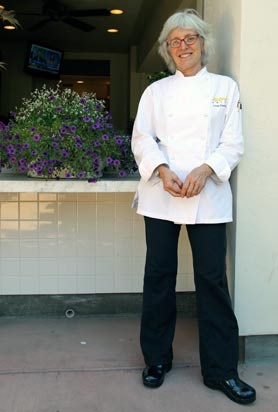Cindy Pawlcyn's Go Fish Goes Pan-Med As Brassica
In the 28-odd years Cindy Pawlcyn has spent as a chef and restaurateur in California wine country, she's seen lots of change. Case in point: The restaurant garden trend. "We've been doing that for years," she noted, laughing. "I planted the garden at Mustard's in 1983 and now it's cool." But some of the biggest changes she's witnessed lately, she participated in. Palcwyn completely changed the concept at Go Fish, her St. Helena sushi restaurant, transforming it into the Mediterranean Brassica.
Click here for the Go Fish Goes Pan-Med as Brassica Slideshow.
Last November, Pawlcyn was selected as culinary director for the Monterey Bay Aquarium. As she explained during a conversation at Brassica (after inviting The Daily Meal into the restaurant to check out what they're doing), sustainability has always been important to her. However, her new affiliation created an urgent need to reevaluate the sustainability of food served at Go Fish. "Ken Tominaga, our sushi chef, was great," chef Pawlcyn explained. "He was willing to change at first, but he's very Japanese, born and raised in Japan, and to him, sushi means certain things. California sushi just makes his hair curl. You know how that is." They tried to make changes, but it didn't work. "So, we're friends," said Pawlcyn.
Between the sushi kitchen interrupting kitchen flow, people's aversion to doing sushi parties at the restaurant ("even though every party we ever sold had tons of sushi on it," Pawlcyn noted), the chef said Go Fish never really worked. "It was making a little bit of money," she explained with a chuckle. "It paid for itself and gave us $3 some years." In the end, she concluded that when it comes to sushi restaurants, the smaller and more intimate, the better. "This is not a small restaurant, this is a huge place."
Brassica nigra, the yellow mustard that carpets Napa's vineyards.
"We're working with cuisines from around the Mediterranean, which executive chef Darren McRonald is excited about because he's passionate about Italian and French," Pawlcyn explained. "So I've started bringing in things from Turkey, Tunisia, and Morocco, and we've been playing with them for the last couple of years at the supper clubs at Cindy's and those are some of our favorite dishes to work on. We felt it's a wine-friendly region of the world, even though part of that region doesn't drink wine, doesn't drink at all, grapes grow there and the foods of that region go well with wine and that's what people come to the Napa Valley for."
On the menu? Appetizers span the region. Under the category, "From Tapas to Mezze" are hummus and stuffed zucchini blossoms, baba ghanoush and also papas bravas, grilled lamb, and whole sardines ("I can hardly keep them in-house. I have died and went to heaven. Oh my god, people are eating sardines!"). One standout is grilled haloumi, a simple, expert preparation with Greek oregano, chile flakes, and garlic. The oil in which it's prepared helps it retain the just-cooked texture much longer than it usually does. A tomato and lemon cucumber salad with feta takes advantage of tomatoes from Cindy's own garden for a refreshing effect.
Eggplant fries should quickly become a signature dish at Brassica.
But the most interesting appetizer is the eggplant fries — a cool take on something you might not have thought would work. Crispy outside, creamy inside, these thick strips of skin-on eggplant are cut like thick fries. "You soak them for two hours in salted ice water, and it has to be ice water," chef Pawlcyn noted. "We tried regular water and it didn't work. Ice water does something to keep them crisp. And it draws out all the bitterness. Then you drain them really well and roll them in seasoned rice flour. So they're great because gluten-free people can have them." They're then fried in canola oil and served with za'atar and spiced yoghurt for dipping. The fries have to be considered one of the new menu's most fun dishes and they'll undoubtedly be one of Brassica's most popular appetizers.
Larger plates take a similar far-flung approach. There's a chanterelle, pancetta, and thyme pizza (gluten-free also); baked Bolognese; and leek and pancetta risotto with fried egg. There's also a shockingly comforting coriander- and thyme-braised rabbit with fresh pappardelle. Think of the best chicken noodle soup you've ever had, but with more luxurious pasta and reinterpreted with rabbit and you get the idea.
Among the entrées you'll find a Tunisian halibut with preserved lemon, California white bass with ouzo and dill butter, grilled chicken with piquillo gazpacho sauce, and grilled rib eye with romesco. Playing off the Mediterranean theme, there's lamb, of course, "Moroccan" with golden raisins and couscous. But there are also kebabs that integrate a little of California by including poblanos with traditional accompaniments like roasted tomato and eggplant. Quail with braised figs, port glaze, and creamy polenta sounds like a fall dish, heavy and sweet, but it's neither — a satisfying dish in balance.
Food wasn't the only thing to change at Brassica. Cindy and partner Sean Knight rebooted the wine program too, trying to create a wine experience not present in the Valley. They started by increasing the depth of the by-the-glass program to 80 wines, doing two-ounce and five-ounce pours, and installing an argon system. "We knew the wine on tap program was one of the hot new things, but I didn't want to get wines that were in the marketplace right now," said Knight. "A lot of those wines are good, they're very approachable, but I wanted to take things to a different level."
That meant leveraging relationships with vineyards to get keg wines that they could have on tap that not everyone else had. Knight said they partnered with Jim Neal of N2 wines, "His reputation is good so it enabled me to reach out to some of these vintners." They plan to have eight wines on tap, among them: a sauvignon blanc from Cliff Lede Vineyards (which Knight said no one else will have); Staglin Vineyards' chardonnay blend, Stagliano Treviso; a chardonnay from Vine Cliff Winery that Rob and Chuck Sweeney put together using their carneros grapes; Markham Vineyard's merlot; a malbec from Miner Family Vineyards; verdejo by Dancing Coyote; and a tempranillo by Six Sigma.
New wine taps for kegged wine behind the bar at Brassica.
Then there's the "Brassica 12" and the "Dirty Dozen." Brassica's license allows them to sell wine to customers to take with them. "I contacted a couple of vintners that don't have tasting rooms and said, 'Hey, what if we had a group of you guys that we put together where we acted as your virtual tasting room. We sell your wine, people taste your wine, and when we sell the wine, we'll actually share the information so that you can build your mailing list.' So really, a true partnership with the restaurant and the wineries building each other's businesses. And I got a great response."
A dozen small-production Napa winemakers are on board (the Brassica 12): Herb Lamb Vineyards, El Molino, Hudson Vineyards, Rossi-Wallace, Jelly Jar, Favia, Lang & Reed, Larkin, Dancing Hares, Bressler, Jaffe Estate, and Arietta. Brassica sells the wine at the vineyards' mailing list price (retail price) for take-home sale, either by the bottle or the case, the Dirty Dozen being a 12-pack including one each of the Brassica 12 wines for $630. "This is something no one else is doing," Knight noted, something that seems to be a theme at a new restaurant being run by experienced hands in a familiar space.

